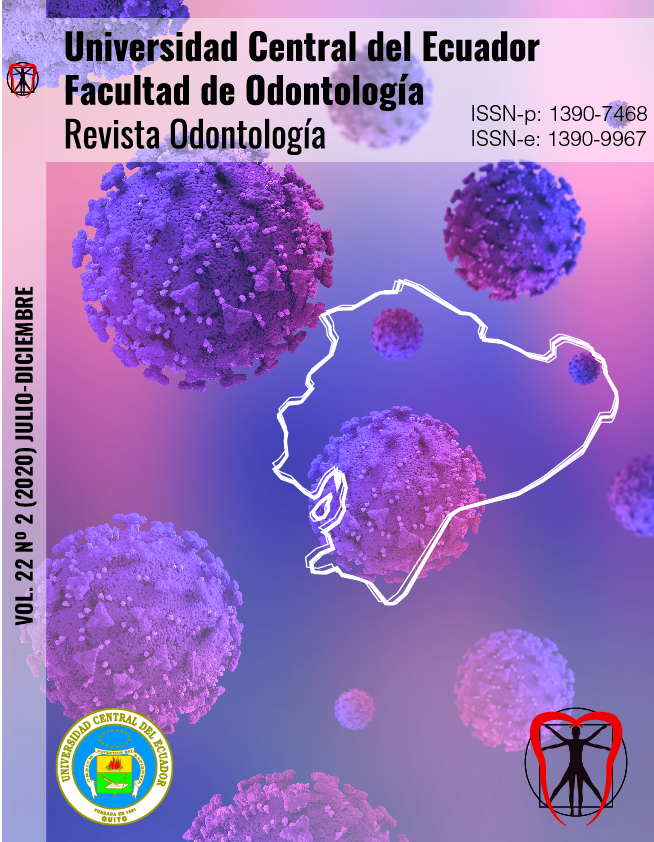Van der woude syndrome - Case report
DOI:
https://doi.org/10.29166/odontologia.vol22.n2.2020-119-129Keywords:
Cleft lip, cleft palate, congenital abnormalities, maxillofacial abnormalities, syndromeAbstract
The Van der Woude Syndrome is a rare anomaly that affects orofacial structures and has been insufficiently reported in Latin America; its identification can be overlooked because it is closely related to cleft lip and palate. The objective of the article is to carry out, to our knowledge, the first report in Ecuador on this Syndrome characterized by the congenital association of sinuses in the lower lips with cleft lip and palate. In the Clinic of Lip and Cleft Palate of the Catholic University of Cuenca, a 6-year-old patient with the following characteristics presented in consultation: symmetrical lip fistulas on the lower lip; Asymptomatic and with sequelae of the lip and palate fissured with extreme salivation and dripping through the lip area upon chewing. The SVW may have other important clinical findings such as: skin folds in the limbs, hypodontia, bifid uvula, hookworm, and sensorineural hearing loss, of which the patient only presented bifid uvula and lip fistulas in addition to the sequela of LPF. The main diagnosis is purely clinical, therefore, complementary diagnoses are not needed, using routine studies such as preoperative laboratory exams, plus pediatric anesthesia and cardiology evaluation. The patient had sequelae from her first LPF surgery, so she underwent a new intervention and excision of the lip fistulas without any resulting sequela. Conclusion: In a case of cleft lip and palate with lip fistulas, an inter-consultation with pediatrics should always be carried out to rule out associated syndromes and proceed to their surgical excision, to avoid discomfort during the patient's chewing and for later cosmetic purposes. The surgical technique performed was the Spindle Technique (Fistulectomy), with which the ductal path is completely eliminated and a plane closure of the lip is performed, resulting in no sequelae.
Downloads
References
Goudy S, Leslie E,Saal H, Schutte S. IRF6-Related Disorders. U.S National Library of Medicine. 2014:1-15.
Klausler M, Schinzel A. The Van derWoude syndrome (dominantly inherited lip pits and clefts). Journal ofMedicalGenetics: 1986;23:291-294
Rizos M, Spyropoulos M. Van derWoude síndrome: a review. Cardinal signs, epidemiology, associated features, differential diagnosis, expressivity, genetic counseling and treatment. European Journal of Orthodontics. 2004;26(1):17-24.
Goswami S. Van derWoude Syndrome: A Report of Four Cases. Archives of Medicine and Health Sciences Journal. 2017;5:248-51.
Behnia H, Mina M, Nadjmi N, Yassaee VR, Ravesh Z, Tehranchi A. Multidisciplinary management of a patient with van derWoude syndrome: A case report. Int J Surg Case Rep 2017;30:142 7.
More CB, Tailor M, BhavsarK,Varma S. Van derWoude syndrome: Report of two cases with supplementary findings. Indian J Dent Res 2013;24:387 9.
Benson AG, Djalilian HR, Ziai MN. Congenital lip pits and van derWoude syndrome. J CraniofacSurg 2005;16:930 2.
Anderson PJ, David DJ,Lam AK,Townsend GC. Van derWoude syndrome: Dentofacial features and implications for clinical practice. Aust Dent J 2010;55:51 8.
Lázaro J, González M, Abarca L, Repollés M. Sindrome de Van derWoude: a propósito de un caso. ProgObstetGinecol. 2003;46(3):147-50.
Puertas N, Ranguel C. Síndrome de Van derWoude en gemelas monocigotas y dos casos familiares. Odous Científica. 2009; 10 (1): 26-32.


